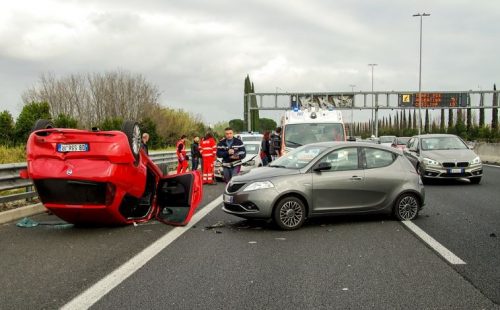
According to the National Highway Traffic Safety Administration, over 2.7 million people were injured in traffic crashes in 2019 alone. The following describes some of the more common injuries.
Soft Tissue Injuries
Soft tissue injuries affect connective tissues, such as the muscles, ligaments, and tendons, and are the most common type. They fall into the following categories:
- Bruising or Contusions. Even a minor collision can push you into your seat belt. While you’re protected from serious harm, you may suffer a bruise. Bruises are generally not serious and do not require medical help. They generally heal in a week or so.
- When your neck snaps forward, similar to the cracking of a whip, you may suffer from whiplash, which is felt as pain or discomfort in your neck and back. Although the strain on your muscles and ligaments may be painful, they generally do not require medical help and will heal in a few weeks.
- Other Neck and Back Injuries. The sudden movement of your body during a collision can cause damage that is not immediately obvious. You may rupture a disk or get a hernia that can limit your mobility. It’s generally a good idea to consult a doctor after an accident to determine the extent of any damage. Your body will eventually heal but may require time, physical therapy, or surgery.
Scrapes and Cuts
Loose objects in your car, such as smartphones, coffee mugs, purses, books, sunglasses, and eyeglasses can go flying during an accident. Your limbs are also thrown around. If your skin comes into contact with these objects or part of your car, you could suffer a scrape or cut. Most of these injuries are minor and require no medical attention. However, a deep cut may require stitches.
Head Injuries
Head injuries may result in nothing more serious than a headache that requires only rest to eliminate. Or they may be more severe, as in the following.
- When you hit your head on the headrest, window, or other parts of your vehicle, you may get a concussion, which bounces or twists your brain in the skull. While this type of injury may not be life-threatening, it can be serious. You may forget what happened before or after the accident, talk slowly, appear dazed or confused, feel nauseous, vomit, or just feel out of it. Immediate medical treatment is needed to bring you back to normal.
- Traumatic Brain Injuries. If your head hits a car component or an object hits your head, you could suffer a traumatic brain injury that is very serious. The pain in your head or neck can be accompanied by confusion, blurred vision, dizziness, seizures, sensory problems, and numbness in your extremities. Treating such injuries may take the rest of your life.
Other Injuries
An accident may hurt other parts of your body, such as your chest, arms, and legs. It’s common for the knees of passengers to hit seatbacks or dashboards. If your bones are stressed, such as with your arm being immobilized by your body and the door, you may get a fracture. While these can be painful, they are typically neither permanent nor life-threatening. However, those bones may need surgery to repair.
A car accident, especially as a result of a high-speed collision, may damage your delicate internal organs, causing them to bleed. Internal bleeding can prove to be life-threatening and must be treated immediately.
Non-Physical Injuries
Arguably a more insidious type of injury because it is invisible is the non-physical variety. Post Traumatic Stress Syndrome, or PTSD, consists of the mental and emotional issues that can arise after an extremely stressful event, such as a car accident. Symptoms can include seeing images or sounds associated with the accident, being afraid of driving, nightmares about the collision, or sleep problems. The best way to combat PTSD is to be treated by therapists or psychologists.
What to Do After an Accident
After an accident, you need to protect yourself and the people around you by taking the following steps.
- Determine if anyone is hurt. Check yourself and your passengers before ensuring that any other parties are injured. If someone is hurt, call 911 to get immediate help.
- Call the police if the accident is serious or involves injury.
- Call your Department of Motor Vehicles if the incident meets certain threshholds, such as damage over a certain amount or anybody has suffered injuries.
- Make the area safe, which may mean moving vehicles out of traffic, or setting up road flares or warning triangles so that traffic can move around you.
- Exchange information with all involved parties including driver’s license, insurance cards, and contact information. Get contact information from potential witnesses. Don’t forget to check nearby buildings for any potential witnesses.
- Take pictures of all vehicles, including license plates and damage, people involved, road conditions, weather conditions, traffic signs and signals, and property damage. Don’t forget to get photos of your surroundings if pertinent, such as skid marks. Note any cameras on nearby buildings or lampposts that might have recorded the accident.
- Document what happened in as much detail as possible while the incident is still fresh. The quickest way would be to record audio commentary on your smartphone.
- Call your insurance company to report the accident.
- Phone us if you or your passengers are injured in a car accident. We’ll advise you on what to do next and what other information you need to collect.
- Beyond finding out if the other parties are okay, avoid talking with them because anything you say can be used against you. Make no promises, do not admit fault, and do not sign anything.
- Get a physical checkup from your doctor to determine if you have any hidden injuries. Recommend that your passengers to do the same.
Interesting Related Article: “5 Things to do in Case of a Car Accident“

